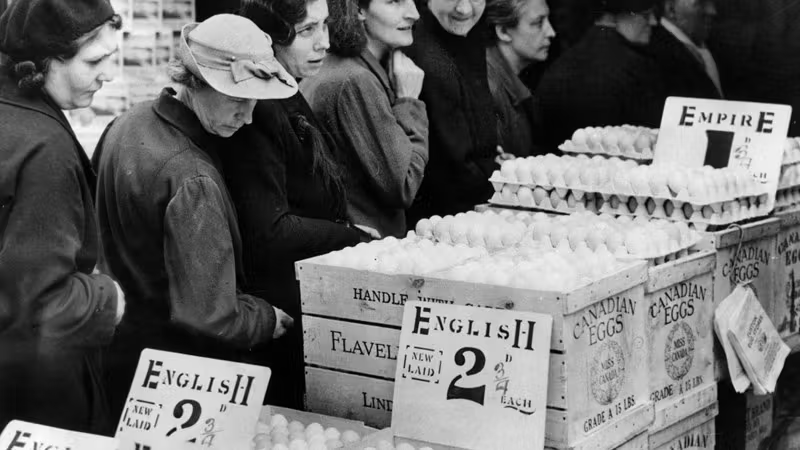This Old-Fashioned Christmas Pudding from Jacq over at traditionalplantbasedcooking.com revives a vintage WW2 British recipe from the 1940s. This interesting recipe provided many people with delicious Christmas pudding during the rationing and food shortages that occurred in Britain during and after the Second World War.
Grandads Cookbook is a collection of recipes from various sources reproduced here for convenience. Recipes are accredited to their original author where known and links are provided to any online source materials.

Surprisingly, this Christmas pudding features grated carrot and grated potato, but the finished result is an incredibly delicious, moist pudding that tastes like Christmas but with hints of toffee! As food shortages and rationing were in full swing many people experienced a shortage of eggs so many useful tasty eggless recipes were created.

A Recipe From My Britain At War Collection

During WWII and for nearly 10 years afterwards, the UK population was subject to food rationing. To feed the family some very creative recipes were used to make the best of the available foodstuffs. Eggs and meat in particular were severely restricted.

Rationing finally ended in 1954 when the last item, meat was made freely available.

WW2 Christmas Pudding
Ingredients
For the milk mixture:
- 1 tsp bicarbonate of soda
- 2 tbsp milk
For the pudding:
- 115 grams plain flour
- 50 grams breadcrumbs any breadcrumbs can be used, such as wholemeal or white
- 145 grams mixed dried fruit
- 190 grams sugar use any sugar such as granulated, caster, or light brown sugar
- 60 grams suet
- 150 grams potato grated
- 110 grams carrot grated
- 3 teaspoons mixed spice powder
Conversions
Instructions
Prepare the milk mixture:
- Stir the bicarbonate of soda through the hot milk in a small bowl.
- 1 teaspoon bicarbonate of soda, 2 tablespoon plant-based milk
To make the pudding:
- Add the rest of the ingredients to a mixing bowl, pour the milk mixture in, and stir well.
- Scoop and pack the pudding mixture into a greased pudding bowl, smoothing out the top.
- Cover the bowl with your homemade lid – a layer of greaseproof paper covered with a layer of kitchen foil and both tied tightly around the pudding bowl rim with a double knot of string. See the instruction video above this recipe card, in the recipe notes, for a useful visual instructions.
- If you have a pudding basin with a lid then the home-made lid can be omitted and the pudding lid placed over the pudding bowl.
- (For extra protection from water, you can add an extra layer of kitchen foil around the lid. Just scrunch and press the foil around lid. However, this is optional)
- Add a heatproof saucer or trivet on to the bottom of the cooking pot.
- Place the pudding bowl on top of the saucer or trivet in the pot.
- Pour boiling water down the sides into your pot being carefully not to pour any water over the pudding.
- Add enough water so that it sits about ½ to ¾ of the way up the pudding bowl sides.
- Bring the water back to the boil and then turn the heat to medium.
- Place the lid over your pot, leaving a small gap for excess steam to escape
- Gently boil for 4 hours.
- Check your water level regularly to maintain the water at least half of the way up the pudding bowl.
- Top the water up when necessary with more boiling water.
- After 4 hours turn off the heat and leave to cool slightly before removing the pudding basin from the pot.
- Remove the lid and check the pudding for doneness.
- Watch out for escaping steam.
- If the pudding looks too wet or not completely cooked in the middle then steam again for 30 minutes and check again.
- Tip the pudding upside down and place on a serving plate.
- If the pudding does not slide out easily, use a butter knife and loosen the sides and tip upside down. It should easily slide out.
- To reheat, place the pudding back in the pudding bowl and steadily simmer for 30 minutes to reheat.
Notes
- Nutritional information is provided for guidance only and is not a strict calculation as ingredients vary.
- Leftovers can be stored refrigerated for up to 4 days and eaten chilled or reheated.
- Reheat by placing it in a hot oven, cover the pudding in kitchen foil, and reheat for 20 minutes or until warmed through. If reheating a whole pudding, place it back in the pudding basin, add the lid, and simmer in boiling water for 30-60 minutes.
- Serve Christmas pudding with vegan custard, cream, yoghurt, or ice cream.
You may also like one of my other favourite recipes …



